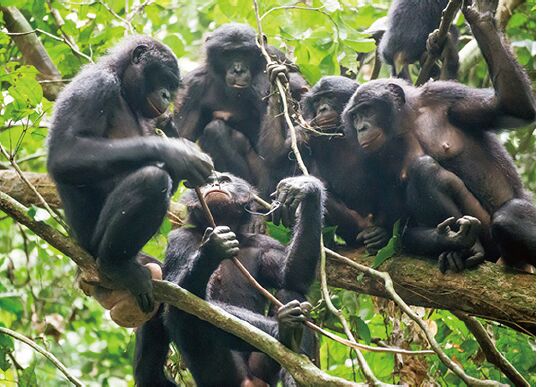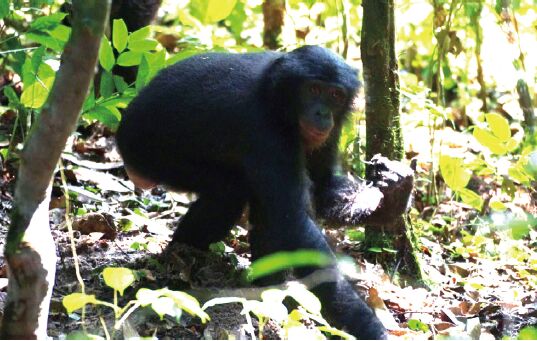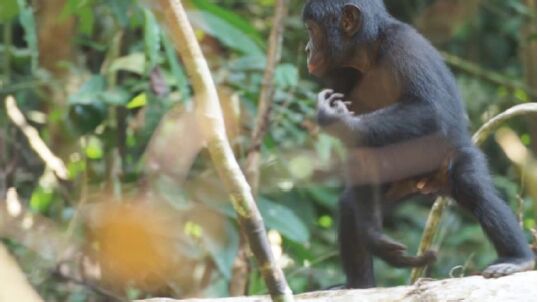|
<NOTE>
An Infant Bonobo Mimicked a Handicapped Motor Action of a Disabled Individual at Wamba in the Luo Scientific Reserve, Democratic Republic of Congo
Kazuya Toda, Heungjin Ryu, Misato Hayashi & Takeshi Furuichi
Primate Research Institute, Kyoto University, Japan INTRODUCTION Imitative abilities to copy the behaviors of others are important for humans to acquire novel skills (Tomasello et al. 1993). Scientific research has focused on whether non-human primates have these abilities, and experimental imitation studies in our nearest primates have been carried out (reviewed by Whiten 2015). Based on cognitive experiments of captive great apes, their leaning processes were classified as “emulation” to reproduce desirable results of the actions of others, rather than “imitations” to reproduce the behavior itself (Whiten et al. 2004). Another experimental evidences indicated that chimpanzees imitate others’ actions, whereas they are less sensitive to body movements than to manipulated objects involved in the demonstrated actions (Myowa-Yamakoshi & Matsuzawa 1999). However, it remained unclear whether great apes can learn to reproduce novel motor actions by bodily matching. “Do-as-I-do” experiments of chimpanzees provided positive evidence that they can copy the form of human actions through a battery of training actions (Custance et al. 1995). Moreover, Fuhrmann et al. (2014) provided the first quantitative evidence for motor copying with synchrony between the movements of the observers and models in chimpanzees and orangutans. This learning behavior was referred to as “mimicking” rather than imitation in that copying motor actions did not have a physical goal to reproduce desirable results of the models’ actions. Nevertheless, these experiments showed that great apes have the capacity to learn novel and simple motor actions by bodily matching. Observations of social learning in great apes under natural conditions are valuable, because experience of cognitive experiments in captivity can affect and enhance the enculturated skills of these apes (Hirata et al. 2009). At Bossou in Guinea, infant chimpanzees acquired stone-nut manipulation through close observations of skilled manipulation by adult individuals (Inoue-Nakamura & Matsuzawa 1997). Hobaiter and Byrne (2010) reported that young chimpanzees copied a motor procedure with a liana-scratch technique from a disabled chimpanzee at the Budongo Forest Reserve in Uganda. However, no reports exist of motor mimicking based on visual information of the body movements of others in wild conditions. We observed an instance of an infant bonobo (Pan paniscus) mimicking a handicapped motor action spontaneously from a disabled individual at Wamba. This report could be the first evidence of motor mimicking in wild infant bonobos. STUDY SITE & BACKGROUND Observational study of bonobo behaviors was carried out at Wamba in the Luo Scientific Reserve, Democratic Republic of Congo. One main study group of bonobos (E1) was habituated fully and the all members were identified. At the time of the present observation, the E1 group consisted of 34 individuals: 8 adult males, 8 adult females, 4 adolescents, 6 juveniles, and 6 infants. Researchers and field assistants followed the largest party daily as far as possible from bed to bed (around 06:00 to 17:00 h), and recorded ad libitum behaviors of bonobos. Snare injuries to wild chimpanzees are serious problems at some study sites (Quiatt et al. 2002). Although the use of traditional techniques is allowed at Wamba in the Luo Scientific Reserve, the use of metallic snares is prohibited to protect primates (Furuichi et al. 2012). However, Wamba bonobos are sometimes caught and injured by metallic snares. An adolescent female (Pf) immigrated into the E1 group from the western adjacent group in October 15, 2013. Unfortunately, Pf was caught in a metallic spring-type snare made from an iron wire attached to an arched branch on July 22, 2014, when KT and TF followed a party of the E1 group. A field assistant used a machete to release Pf from the snare, after which Pf quickly climbed up the trees with the rest of the snare still attached. The following morning, some adult females and offspring peered at her ensnared hand and tried to pull and bite the snare (Figure 1). Although one female successfully removed the branch portion, the iron wire had ensnared the fingers. Since then, Pf had had a handicapped motor action, without the use of the left hand, so as to hold the fingers to the inside of the wrist (Figure 2, also see Video 1 available online at http://mahale.main.jp/PAN/23_1/23(1)_02.html). 

OBSERVATION On the morning of November 29, 2014, an infant male (SE) 2 years and 11 months old seemed to adopt a behavior similar to the handicapped motor action of Pf in two scenes, observed by KT and HR, who were following a party of the E1 group at a sleeping site from 05:31 h onwards. The party consisted of 10 individuals, including Pf and SE. We observed that SE walked and played without the use of his left hand from 08:12 h to 09:27 h, when most individuals had begun to take part in grooming in the group (Figure 3: also see Video 2 available online http://mahale.main.jp/PAN/23_1/23(1)_02.html). In a scene from Video 2, he hanged the left hand powerlessly and held the left fingers to the inside of the wrist, while poking another individual in the face, walking on a fallen tree, and peering into grooming individuals. This unusual behavior by SE had been observed previously neither before nor after Pf’s capture in the metallic snare. We could not confirm any external injuries to the finger of SE’s hand. We did not observe this behavior in SE after this grooming session, when the party fed on grounds and in high trees. The party being followed by researchers moved in the direction of the voices of another party at 11:58 h, and they fused into this party, which consisted of 17 individuals at 12:08 h. From 12:11 h to 12:45 h, most adults rested and four offspring played socially, engaging in behaviors such as wrestling and chasing. The social plays involved active motions on the ground and in low trees, such as kicking on others’ backs, butting each other with play pants, and trying to grab legs or trunk of others hanging from branches with their arms. SE again showed successively the handicapped motor action during the period of social plays. SE occasionally used his left hand to grab others’ body and walk on trees: therefore, he did not seem to have a physical problem using this hand. The party then moved on and fed on piths on the grounds. We did not observe this unusual motor action again. 
DISCUSSION We observed that SE seemed to pretend not being able to use his able left hand. His behavior may be considered a “handicap play” similar to a report of a captive bonobo who covered her eyes with her hands until she lost her balance (de Waal 1995). In the present case, SE’s handicap play was likely to stem from the Pf’s handicapped motor actions. He seemed to acquire the similar motor action from visual information of her body movements. The physical copying of a non-functional motor act can be considered motor mimicking. This report may provide evidence that bonobos can reproduce the form of novel motor actions by spontaneous bodily matching in the wild. Field studies of Bossou chimpanzees have suggested a critical period ranging from 3 to 5 years old to learn nut-cracking (Biro et al. 2003). Also, the field study of Budongo Forest Reserve reported that younger chimpanzees at 4–13 years old acquired the liana-scratch technique (Hobaiter & Byrne 2010). This motor mimicking case by an infant bonobo is consistent with these studies in that immature individuals tend to reproduce others’ behavior from the visual information. Further study is needed to explore how this playful mimicking is widespread among immature great apes and related to the development of their social learning skills. ACKNOWLEDGMENTS We sincerely thank the Research Center for Ecology and Forestry and Ministry of Scientific Research, DRC for helping our field research. We are also grateful to field assistants and others at Wamba for their support during our study. This research was financially supported by the Leading Graduate Program in Primatology and Wildlife Science of Kyoto University, and Grant in Aid for Scientific Research to TF and Asia-Africa Science Platform Program to TF from the Japan Society for the Promotion of Science. REFERENCES Biro D, Inoue-Nakamura N, Tonooka R et al. 2003. Cultural innovation and transmission of tool use in wild chimpanzees, evidence from field experiments. Anim Cogn 6:213–223. Custance DM, Whiten A, Bard KA 1995. Can young chimpanzees (Pan troglodytes) imitate arbitrary actions? Hayes & Hayes (1952) revisited. Behaviour 132:837–859. de Waal FBM 1995. Bonobo sex and society. Sci Am 272:82–88. Fuhrmann D, Ravignani A, Marshall-Pescini S, Whiten A 2014. Synchrony and motor mimicking in chimpanzee observational learning. Sci Rep 4:1–7. Furuichi T, Idani G, Ihobe H et al. 2012. Long-term studies on wild bonobos at Wamba, Luo Scientific Reserve, D. R. Congo: Towards the understanding of female life history in a male-philopatric species. In: Long-Term Studies of Primates: Kappeler PM, Watts DP (eds), Springer, Verlag Berlin Heidelberg, pp. 413–433. Hirata S, Morimura N, Houki C 2009. How to crack nuts: Acquisition process in captive chimpanzees (Pan troglodytes) observing a model. Anim Cogn 12:87–101. Hobaiter C, Byrne RW 2010. Able-bodied wild chimpanzees imitate a motor procedure used by a disabled individual to overcome handicap. PLoS One 5:1–7. Inoue-Nakamura N, Matsuzawa T 1997. Development of stone tool use by wild chimpanzees (Pan troglodytes). J Comp Psychol 11:159–173. Myowa-Yamakoshi M, Matsuzawa T 1999. Factors influencing imitation of manipulatory actions in chimpanzees (Pan troglodytes). J Comp Phychol 113:128–136. Quiatt D, Reynolds V, Stokes EJ 2002. Snare injuries to chimpanzees (Pan troglodytes) at 10 study sites in east and west Africa. Afr J Ecol 40:303–305. Tomasello M, Savage-Rumbaugh S, Kruger AC 1993. Imitative learning of actions on objects by children, chimpanzees, and enculturated chimpanzees. Child Dev 64:1688–1705. Whiten A 2015. Experimental studies illuminate the cultural transmission of percussive technologies in Homo and Pan. Phil Trans R Soc B 370:20140359. Whiten A, Horner V, Litchfield CA, Marshall-Pescini S 2004. How do apes ape? Learn Behav 32:36–52. Back to Contents |